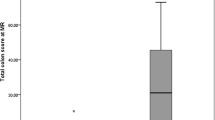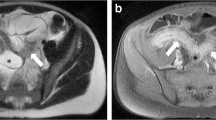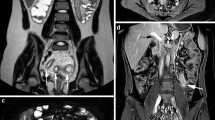Abstract
Background
Colonic involvement in pediatric inflammatory bowel disease is common. Magnetic resonance (MR) enterography is considered the best imaging modality for pediatric inflammatory bowel disease evaluation. It is unclear whether the lack of a dedicated large bowel preparation prevents a reliable colonic assessment.
Objective
To determine the diagnostic performance of standard MR enterography in detecting and grading colonic inflammatory activity.
Materials and methods
We retrospectively evaluated children who underwent both MR enterography and ileocolonoscopy with biopsies <4 weeks apart. Two radiologists independently reviewed MR examinations and quantified inflammation in each of the five colonic segments using a standardized MR score system. Findings were compared with histological examination of the corresponding segment. Mann-Whitney, Kruskal-Wallis, Jonckheere-Terpstra and Bland-Altman statistics were used.
Results
One hundred seventy-five segments from 37 examinations were included. MR enterography diagnostic performance for inflammation was as follows: sensitivity 94% (95% confidence interval [CI]: 90-97%), specificity: 64% (95% CI: 57-71%). A significant positive correlation was found between MR score and inflammatory activity histologically graded (P<0.001, Jonckheere-Terpstra test). The interobserver agreement was good (mean difference between MR enterography scores was -0.03; limits of agreement -2.8 to 2.7).
Conclusion
Standard MR enterography is sensitive for the detection of actively inflamed colonic segments. MR enterography might provide useful information for guiding biopsies and its role as an alternative to ileocolonoscopy in monitoring colonic disease activity in children should be further investigated.





Similar content being viewed by others
References
Higuchi L, Bousvaros A (2016) Clinical presentation and diagnosis of IBD in infant, children, and adolescents. In: UpToDate, Waltham, MA (topic last updated on 25 Feb 2016)
Levine A, Koletzko S, Turner D et al (2014) ESPGHAN revised Porto criteria for the diagnosis of inflammatory bowel disease in children and adolescents. J Pediatr Gastroenterol Nutr 58:795–806
Kappelman MD, Moore KR, Allen JK et al (2013) Recent trends in the prevalence of Crohn's disease and ulcerative colitis in a commercially insured US population. Dig Dis Sci 58:519–525
Malaty HM, Fan X, Opekun AR et al (2010) Rising incidence of inflammatory bowel disease among children: a 12-year study. J Pediatr Gastroenterol Nutr 50:27–31
Maccioni F, Viola F, Carrozzo F et al (2012) Differences in the location and activity of intestinal Crohn's disease lesions between adult and paediatric patients detected with MRI. Eur Radiol 22:2465–2477
Magro F, Langner C, Driessen A et al (2013) European consensus on the histopathology of inflammatory bowel disease. J Crohns Colitis 7:827–851
IBD Working Group of the European Society for Paediatric Gastroenterology, Hepatology and Nutrition (2005) Inflammatory bowel disease in children and adolescents: recommendations for diagnosis--the Porto criteria. J Pediatr Gastroenterol Nutr 41:1–7
Anupindi SA, Podberesky DJ, Towbin AJ et al (2015) Pediatric inflammatory bowel disease: imaging issues with targeted solutions. Abdom Imaging 40:975–992
Maltz R, Podberesky DJ, Saeed SA (2014) Imaging modalities in pediatric inflammatory bowel disease. Curr Opin Pediatr 26:590–596
Neubauer H, Pabst T, Dick A et al (2013) Small-bowel MRI in children and young adults with Crohn disease: retrospective head-to-head comparison of contrast-enhanced and diffusion-weighted MRI. Pediatr Radiol 43:103–114
Barber JL, Lozinsky AC, Kiparissi F et al (2016) Detecting inflammation in the unprepared pediatric colon - how reliable is magnetic resonance enterography? Pediatr Radiol 46:646–652
Hafeez R, Punwani S, Pendse D et al (2011) Derivation of a T2-weighted MRI total colonic inflammation score (TCIS) for assessment of patients with severe acute inflammatory colitis-a preliminary study. Eur Radiol 21:366–377
Makanyanga JC, Pendse D, Dikaios N et al (2014) Evaluation of Crohn's disease activity: initial validation of a magnetic resonance enterography global score (MEGS) against faecal calprotectin. Eur Radiol 24:277–287
Maccioni F, Al Ansari N, Mazzamurro F et al (2014) Detection of Crohn disease lesions of the small and large bowel in pediatric patients: diagnostic value of MR enterography versus reference examinations. AJR Am J Roentgenol 203:W533–W542
Sirin S, Kathemann S, Schweiger B et al (2015) Magnetic resonance colonography including diffusion-weighted imaging in children and adolescents with inflammatory bowel disease: do we really need intravenous contrast? Investig Radiol 50:32–39
Dillman JR, Ladino-Torres MF, Adler J et al (2011) Comparison of MR enterography and histopathology in the evaluation of pediatric Crohn disease. Pediatr Radiol 41:1552–1558
Gee MS, Nimkin K, Hsu M et al (2011) Prospective evaluation of MR enterography as the primary imaging modality for pediatric Crohn disease assessment. AJR Am J Roentgenol 197:224–231
Ajaj WM, Lauenstein TC, Pelster G et al (2005) Magnetic resonance colonography for the detection of inflammatory diseases of the large bowel: quantifying the inflammatory activity. Gut 54:257–263
Rimola J, Rodriguez S, Garcia-Bosch O et al (2009) Magnetic resonance for assessment of disease activity and severity in ileocolonic Crohn's disease. Gut 58:1113–1120
Kim KJ, Lee Y, Park SH et al (2015) Diffusion-weighted MR enterography for evaluating Crohn's disease: how does it add diagnostically to conventional MR enterography? Inflamm Bowel Dis 21:101–109
Shenoy-Bhangle AS, Nimkin K, Aranson T et al (2016) Value of diffusion-weighted imaging when added to magnetic resonance enterographic evaluation of Crohn disease in children. Pediatr Radiol 46:34–42
ASGE Standards of Practice Committee, Fisher DA, Maple JT et al (2011) Complications of colonoscopy. Gastrointest Endosc 74:745–752
Steward MJ, Punwani S, Proctor I et al (2012) Non-perforating small bowel Crohn's disease assessed by MRI enterography: derivation and histopathological validation of an MR-based activity index. Eur J Radiol 81:2080–2088
Sauer CG, Middleton JP, Alazraki A et al (2012) Comparison of magnetic resonance enterography with endoscopy, histopathology, and laboratory evaluation in pediatric Crohn disease. J Pediatr Gastroenterol Nutr 55:178–184
Bousvaros A (2016) Overview of the management of Crohn disease in children and adolescents. In: UpToDate, Waltham, MA (topic last updated on 29 May 2016)
Thakkar K, El-Serag HB, Mattek N et al (2008) Complications of pediatric colonoscopy: a five-year multicenter experience. Clin Gastroenterol Hepatol 6:515–520
Novak KL, Panaccione R (2014) Will cross-sectional imaging replace endoscopy for monitoring response to therapy in Crohn's disease? Gastroenterology 146:334–336
Ordas I, Rimola J, Rodriguez S et al (2014) Accuracy of magnetic resonance enterography in assessing response to therapy and mucosal healing in patients with Crohn's disease. Gastroenterology 146:374–382
Morani AC, Smith EA, Ganeshan D et al (2015) Diffusion-weighted MRI in pediatric inflammatory bowel disease. AJR Am J Roentgenol 204:1269–1277
Rosenbaum DG, Rose ML, Solomon AB et al (2015) Longitudinal diffusion-weighted imaging changes in children with small bowel Crohn's disease: preliminary experience. Abdom Imaging 40:1075–1080
Bhatnagar G, Dikaios N, Prezzi D et al (2015) Changes in dynamic contrast-enhanced pharmacokinetic and diffusion-weighted imaging parameters reflect response to anti-TNF therapy in Crohn's disease. Br J Radiol 88:20150547
Sakuraba H, Ishiguro Y, Hasui K et al (2014) Prediction of maintained mucosal healing in patients with Crohn's disease under treatment with infliximab using diffusion-weighted magnetic resonance imaging. Digestion 89:49–54
Kim SY, Park SH (2015) Reply to what is the role of diffusion-weighted imaging in ileocolonic Crohn's disease? Inflamm Bowel Dis 21:E9–E10
Oto A, Kayhan A, Williams JT et al (2011) Active Crohn's disease in the small bowel: evaluation by diffusion weighted imaging and quantitative dynamic contrast enhanced MR imaging. J Magn Reson Imaging 33:615–624
Dubron C, Avni F, Boutry N et al (2016) Prospective evaluation of free-breathing diffusion-weighted imaging for the detection of inflammatory bowel disease with MR enterography in childhood population. Br J Radiol 89:20150840
Semelka RC, Ramalho M, Jay M (2016) Summary of special issue on gadolinium bioeffects and toxicity with a look to the future. Magn Reson Imaging 34:1399–1401
Mojtahed A, Khanna R, Sandborn WJ et al (2014) Assessment of histologic disease activity in Crohn's disease: a systematic review. Inflamm Bowel Dis 20:2092–2103
Author information
Authors and Affiliations
Corresponding author
Ethics declarations
Conflicts of interest
None
Rights and permissions
About this article
Cite this article
Campari, A., Napolitano, M., Zuin, G. et al. Colonic inflammation in pediatric inflammatory bowel disease: detection with magnetic resonance enterography. Pediatr Radiol 47, 850–859 (2017). https://doi.org/10.1007/s00247-017-3833-x
Received:
Revised:
Accepted:
Published:
Issue Date:
DOI: https://doi.org/10.1007/s00247-017-3833-x




